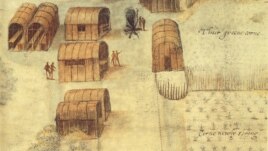26 January 2020
During his time as president of the United States, Gerald Ford decided to build an outdoor swimming pool at the White House. National Park Service workers examined the ground where the pool would be built. They found Native American artifacts, evidence of the people who lived in Washington, D.C. up to 1,000 years ago.
"Very little is known about the earliest Native Americans in Washington, say from 12,000 to 16,000 years ago," said Ruth Trocolli. She is the city archaeologist for the District of Columbia (D.C.). She works to identify and protect the city's archaeological treasures.

Village of the Algonquin-speaking Secotan in North Carolina. Watercolour painted by John White, 1585.
Washington sits at the place where two major rivers, the Potomac and the Anacostia, come together. Those waterways date back to Earth's Ice Age.
"The location was hot, hot, hot for Native Americans...because there was water available all year round," Trocolli said.
The Native Americans went fishing in the Potomac and the Anacostia. Once a year, when shad swam upriver from the Chesapeake Bay, tribes would come inland to what is today Washington and camp near the water.
"They would catch... the fish, probably drying it, and while everyone was together, they probably had parties and feasts and weddings and funerals and spiritual ceremonies," Trocolli said.
At the time when Europeans first arrived in the area, three Native groups had come to power: The Piscataway in southern Maryland; the Susquehannock in Pennsylvania; and the Powhatan in Virginia.
The Nacotchtanke
The people of Nacotchtanke were allied with the Piscataway. They were first noted by English Captain John Smith on a 1612 map of the area. Later changed to "Anacostia," Nacotchtanke was an Algonquin word for "town of traders," wrote the 19th Century Algonquin educator William Wallace Tucker.
Nacotchtanke was made of as many as five villages with a total population of fewer than 400 people, about 80 of them "able men," noted Smith. The main village sat on the east side of the Potomac River at the point where it flows into the Anacostia River. It was the perfect place for trading with other tribes and keeping watch for the arrival of their enemies.
Smith did not describe the people of Nacotchtanke, but eyewitness reports from other Algonquin groups give a good idea of what they looked like and how they lived.
"The natives are of tall...stature, of a skin by nature somewhat tawny," Jesuit clergyman Andrew White wrote of the Yaocomico in 1634.
The men did not have facial hair, he said, but painted the lower half of their faces black. They wore deer skin around their bodies for clothing, and White said they also tied their long hair "in a fashionable style" to one side.
"Their weapons are bows and arrows," wrote White. "They direct these with so much skill that at a distance, they can shoot a (small bird) through the middle."
Moving out of Washington
White also wrote that the Yoacomico had a single god but did not worship him in a formal ceremony. However, they did recognize an evil spirit they called "Okee," and they tried to keep him happy.
About a thousand years ago, the Native Americans in Washington went from being hunters to being farmers.
Just a few streets from the White House, archaeologists in the 1980s found burial grounds. They held the remains of an adult woman who died at least 1,200 years ago.
A half century after the arrival of European settlers, the population of Nacotchtanke had begun to decrease. Some moved to nearby Analostan Island. Others died from disease or joined the Piscataway.
By the time slaves started building the White House in 1792, the Nacotchtanke people were gone.
I'm Susan Shand.
VOA's Cecily Hilleary reported this story. Susan Shand adapted it for Learning English. George Grow was the editor.
_______________________________________________________________
Words In This Story
artifact – n. something discovered at an ancient site
feast – n. a large meal of celebration
wedding – n. a marriage ceremony
stature – n. height
tawny – adj. a brownish yellow color
fashionable – adj. influenced by popular culture
worship – v. to honor or recognize a supernatural being